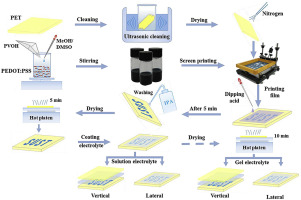Organic Electronics ( IF 2.7 ) Pub Date : 2020-02-26 , DOI: 10.1016/j.orgel.2020.105674 Guodong Liu , Yu Liu , Meiyun Zhang , Zhenhua Yang , Patrick Gane

|
Poly(3,4-ethylenedioxythiophene) (PEDOT), a common constituent material used in the preparation of electrochromic devices (ECDs) when doped with the polymer anion poly(styrenesulfonate) (PSS), can also be used to form an electrode layer. Patterned ECDs may thus be fabricated by conventional spin-coating. Due to high wastage and low productivity in spin coating, the demand for low-cost ECDs is difficult to meet. The alternative use of screen printing, however, results in a major challenge due to difficulty in achieving the necessary continuity of the applied print and of the subsequent film forming uniformity when using standard PEDOT:PSS dispersion alone. The film forming property of PEDOT:PSS is shown here to be improved by dispersing in a water methanol mix to form a novel PEDOT:PSS-solvent compound, which, when combined together with the high boiling solvent dimethyl sulfoxide (DMSO) and a thickening binder solution of polyvinyl alcohol (PVOH), allows screen printing to perform well. The sheet conductivity of the printed PEDOT:PSS compound film is then further increased by studying post-treatment using strong and weak organic acids, illustrated by comparing p-toluenesulfonic acid (tosylic acid (PTSA)) with glacial acetic acid (CH3COOH (HOAc)) or oxalic acid (OA), respectively, over a range of concentration. In this way, the optimal processing concentration of acid is accordingly obtained to minimize sheet resistance. Screen printed patterned ECDs, based on the post-treated PEDOT:PSS compound electrochromic and electrode films using the optimal acid concentrations, were printed including electrolyte layers, were evaluated. Performance of lateral versus vertical ECD build architecture in respect to chromatic aberration, working voltage, time response, ion mobility in electrolyte type (gel/solution), absorbance at color-switching, as well as mechanical stability during repeated bending, was assessed. The optima of chromatic aberration and absorbance at color-switching were found to coincide with minimal sheet resistance of the novel PEDOT:PSS compound films. Almost equivalent sheet resistance was obtained with both PTSA and HOAc, each at optimal treatment dosage, showing newly that the weak organic acid post-treatment provides an equivalent effect in comparison with strong organic acid if used at sufficient concentration. Furthermore, the electrochromic performance of the experimentally prepared ECDs was shown to be close to the level obtained from conventional indium-tin oxide (ITO)-based ECDs, and retained stable performance for color-switching after repeated bending of 1 000 times.
中文翻译:

基于新型PEDOT:PSS复合膜的强,弱有机酸后处理,比较无ITO柔性图案有机丝网印刷ECD的构建体系结构和电解质
聚(3,4-乙撑二氧噻吩)(PEDOT),一种掺杂有聚合物阴离子聚(苯乙烯磺酸盐)(PSS)的电致变色器件(ECD)的制备中常用的组成材料,也可用于形成电极层。图案化的ECD因此可以通过常规旋涂来制造。由于旋涂的高浪费和低生产率,因此难以满足对低成本ECD的需求。然而,当单独使用标准的PEDOT:PSS分散体时,丝网印刷的替代使用由于难以实现所施加的印刷的必要连续性和随后的成膜均匀性而导致了重大挑战。通过将PEDOT:PSS的成膜性能分散在甲醇混合物中以形成新型PEDOT:PSS溶剂化合物,可以改善该性能,当与高沸点溶剂二甲亚砜(DMSO)和聚乙烯醇(PVOH)的增稠粘合剂溶液结合使用时,可使丝网印刷性能良好。然后,通过研究使用强酸和弱酸的后处理来进一步提高印刷的PEDOT:PSS复合膜的片电导率,这可以通过将对甲苯磺酸(甲苯磺酸(PTSA))与冰醋酸(CH)进行比较来说明。3在一定浓度范围内分别为COOH(HOAc))或草酸(OA)。以此方式,因此获得酸的最佳处理浓度以最小化薄层电阻。基于后处理的PEDOT:PSS化合物的电致变色和使用最佳酸浓度的电极膜,对包括电解质层在内的丝网印刷图案化ECD进行了评估。评估了横向和垂直ECD构建体系结构在色差,工作电压,时间响应,电解质类型(凝胶/溶液)中的离子迁移率,颜色转换时的吸光度以及反复弯曲过程中的机械稳定性方面的性能。发现在色转换时色差和吸收率的最佳值与新型PEDOT:PSS复合膜的最小薄层电阻相吻合。PTSA和HOAc均以最佳处理剂量获得了几乎等效的薄层电阻,这表明如果以足够的浓度使用弱有机酸,后处理与强有机酸相比可提供等效的效果。此外,实验制备的ECD的电致变色性能接近于常规的基于铟锡氧化物(ITO)的ECD的水平,并且在反复弯曲1000次后仍保持稳定的色彩切换性能。











































 京公网安备 11010802027423号
京公网安备 11010802027423号